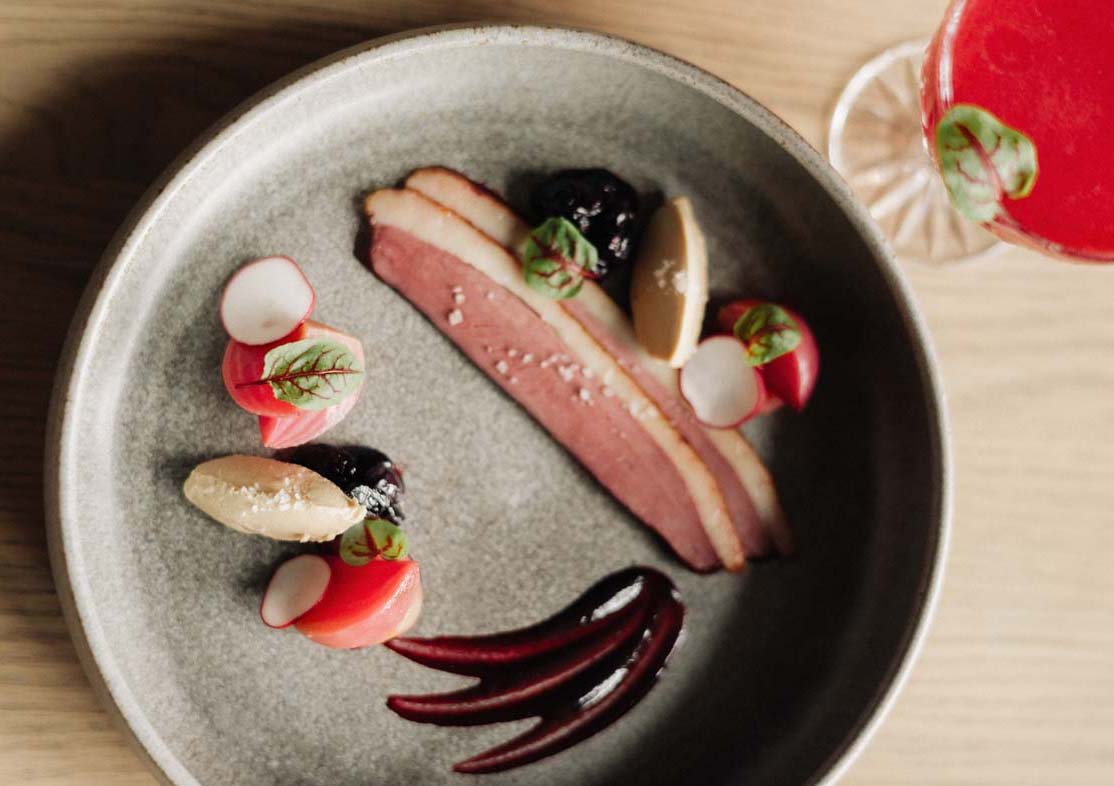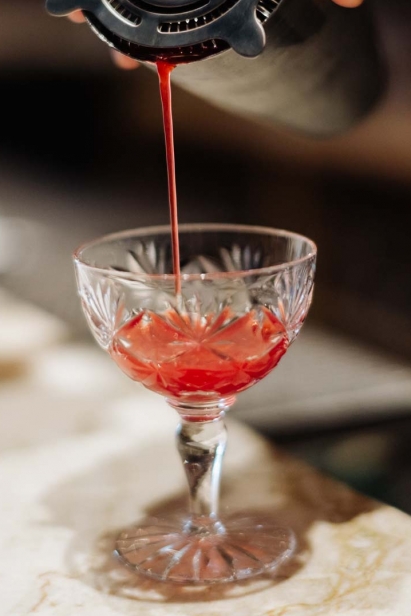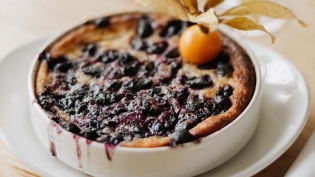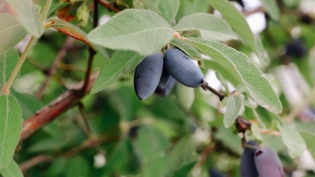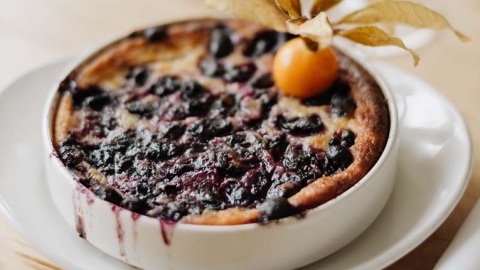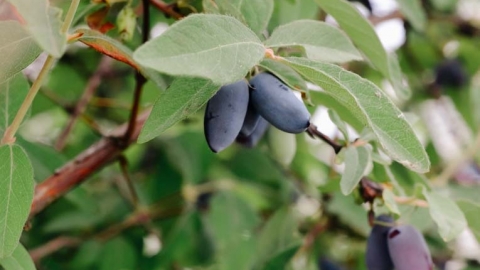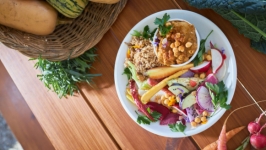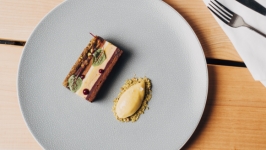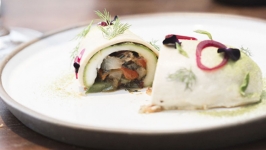Haskaps with Duck Bacon and a Haskap Gin Shrub
If you haven't heard of the haskap until now, you are not alone. But that is all about to change. The haskap is quickly gaining popularity with consumers and farmers alike.
As it turns out, we have the perfect growing conditions in this part of the world. Farmers know that our nutrient-dense soil, warm days and chilly nights are just right for an early-ripening berry that can beat strawberries to market. As a result, they are starting to plant these deciduous shrubs in greater numbers every year.
Chefs are noticing too. Chef Rich Wilson (formerly of Pomeroy House and now at Gezellig) and partner Lindsay Gordon have added haskaps, when in season, to their upscale southern-inspired kitchen menus and well-crafted bar offerings. Gordon's haskap cocktail, plays with all the senses. It's striking in colour, while balancing tart, sweet and floral with a punch of spice. And Wilson’s beautifully composed plate is a culmination of several recipes — pickled beets and haskaps, torchon of foie gras, smoked duck bacon and a gin-infused haskap purée — that pairs the tart haskap with the rich and salty duck and fatty foie gras. Beautiful together, yet simple and versatile enough to make at home.
Duck Bacon with haskaps and foie gras by Rich Wilson
Pickled Haskaps
1 cup white balsamic vinegar
1/4 cup white sugar
1/2 teaspoon coriander seed, ground
1/2 teaspoon dried piri piri chilies
1cup haskap berries
In a small pot over medium-high heat, bring all the ingredients, except the haskap berries, to a boil. Turn the heat off and allow the liquid to cool to room temperature (65-70 F). Pour the liquid over the berries and allow at least one day of pickling before use. The pickled haskaps will keep for four to six months, covered, in the refrigerator.
Pickled haskaps work especially well with fowl and game meats.
Haskap Puree
1 lb haskap
½ lb sugar
1teaspoon salt
1cup water
1/3 cup gin
½ ounce juniper berries
1/5 ounce (5 grams) Xanthan gum
In a small pot over medium-high heat, bring all ingredients (except the gin and the Xanthan gum) to a boil and reduce by 25 per cent. Add the contents of the pot, the gin and the Xanthan gum to a blender and blend until fully incorporated.
Pickled Beets
1 cup beets, boiled and peeled
1 cup white wine vinegar
1/4 cup sugar
1/2 teaspoon mustard seed
1/2 teaspoon coriander
1 teaspoon salt
Place washed beets in a single layer into a pot and cover with cold water. Over medium heat, bring water to a simmer. Cook the beets until a sharp knife is easily inserted through to the centre of the beet. Remove the beets and allow them to cool until they can be handled. Using a knife of peeler, remove the skins from the beets. Cut beets into wedges or in half if they are small. Reserve.
In a small pot, bring the vinegar, sugar, salt and spices up to a simmer. Turn off the heat and let cool to just above room temperature, but still slightly warm.
Pour pickling liquid over the cooked beets. Let the beets pickle for at least 24 hours before using. Beets will keep, covered in the refrigerator, for several months.
Torchon of Foie Gras
1 lb foie gras
1 ounce whiskey
2½ ounces maple syrup
¼ ounce Angostura bitters
3 teaspoons Kosher salt
In a small pot, over medium heat, bring the maple syrup and salt to a simmer, making sure all the salt has been dissolved. Remove from heat and cool.
Remove foie gras from packaging, rinse, pat dry and place onto a plate. Using tweezers or the tip of a sharp knife, starting with the most visible veins, gently pull out as musch of the veining as possible.
Add all the ingredients into a food processor and blend until smooth. Remove puree from food processor and place into a sealable container or roll into plastic wrap. Refrigerate at least 24 hours before using.
Duck Bacon Cure
2 lbs duck breast
½ lb Kosher salt
6 ounes dextrose (corn-based sugar)
2½ tablespoons pink (curing) salt
2 teaspoons black pepper, crushed
2 tablespoons juniper berries, crushed
2 cloves of garlic
In a food processor, blend together both salts, dextrose, black pepper, juniper berries and garlic. Place duck breast(s) into a storage bag or non-reactive container. Cover the duck completely with the curing mixture. Cure for four days, turning the breast periodically and re-covering it in the cure. After the duck has been cured, thoroughly rinse off the curing mixture and let dry (on a wire drying rack, if you have one) overnight.
Smoke the cured duck at 150F for about four hours. Remove duck from smoker and let rest for at least an hour. If you prefer your duck to be cooked more at this point, you can roast it in the oven until your desired doneness.
Note: if you don’t have a smoker, you can use an aluminumfoil packet of wood chips over direct heat on one side of your BBQ, and the duck over no heat on the other side. You can also add several drops of liquid smoke to your curing mixture.
To serve: Cut several lengthwise slices from the breast and place, fanned onto a plate. Add a spoonful each of the haskap puree and pickled haskaps. Form quenelles of foie gras torchon and place onto plate, along with several pieces of pickled beets. Garnish with slices of radish and micro lettuces.
Haskap Gin Shrub by Lindsay Gordon
Haskap Shrub
1½ cups haskap berries
1 cup turbinado sugar
1 cup white balsamic
¼ cinnamon stick
1 piri piri chili
Add all of the ingredients into a medium-sized bowl. Using a hand masher, mash the haskaps to release their juices. Let stand 24 hours or at least overnight in the refrigerator. Strain the liquid into a clean container. Reserve.
The Cocktail
1 ounce gin
½ ounce vermouth
½ ounce Lillet (an oak barrel-aged aperitif wine from France)
¾ ounce haskap shrub
½ ounce lemon juice
Add all of the ingredients into a bar shaker and shake vigorously over ice. Strain into a chilled champagne coupe. Finish with 3 drops of charred cedar bitters and a leaaf of blood sorrel.


